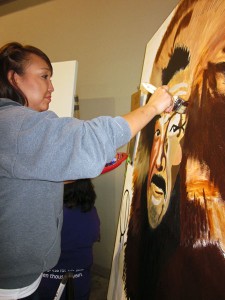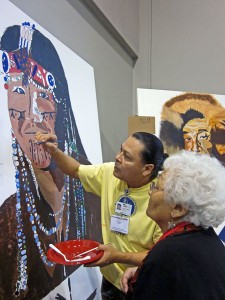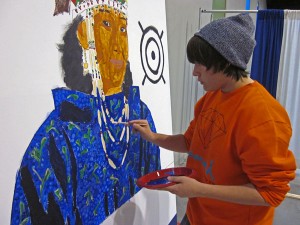Alaska Natives from across the state are meeting in Anchorage this week. And along with all the serious business of the Alaska Federation of Native’s Convention, an Anchorage artist is bringing together people to paint too. At the Elders and Youth Conference earlier this week, Artist Phillip Charette invited attendees to participate in a community art project that captures the spirit of the gatherings.

In a corner of a conference room on the main floor of the Dena’ina Convention Center in downtown Anchorage, Phillip Charette is washing and passing out paintbrushes.
“…Literally hundreds of paintbrushes,” Charette said, laughing as he washed a handful of paintbrushes.
Charette has sketched portraits of Native leaders from different regions of Alaska onto 5×8 foot panels.
“Each of these panels represent each of these panels represent one of the one of the major cultural/linguistic groups in Alaska,” Charette explained. “We’ve got the Yup’ik people represented, the Tlingit people, the Inupiaq people, the Aleut people and the Athabaskan people.”
And he’s letting the public color in his sketches with paint.
“There are people that are part Tlingit and part Inupiaq that are saying I have to paint a little bit on the Inupiaq part and I have to paint a little bit on the Tlingit park and I want to paint a little bit on the Athabaskan part too, because we’re very connected in a lot of ways,” Charette said.
Connecting young Alaska Natives, to their culture is Charette’s job. He runs the Youth Program at the Alaska Native Heritage Center. His program is based on research that shows Alaska Native youth who maintain a connection to their culture and traditions do better in school. Charette is also an artist whose masks, prints and other creations have traveled to galleries throughout the country. Charette is Yup’ik. His mother comes from Western Alaska and his French Canadian father was in the military. He spent his childhood bouncing between Alaska and the Lower 48, and between cultures. During the 1960’s he attended school at Elmendorf air force base, where he says he was abused.

“Back then they did not like Natives at all. Yup’ik was my first language. I was beaten just about every day. I remember having to eat soap just because I spoke a dirty language. I was left-handed, they beat my hand until I couldn’t close it any more. And I remember on a number of occasions being drug down to the office by my hair and being called a dirty, filthy little native boy by my teacher in front of the other kids,” Charette said.
Thankfully, Charette says a lot has changed in Anchorage since those days. But he understands that young people today, particularly in urban areas, have their own challenges. This is Stacey Ivonoff’s second time attending the Elders and Youth conference. The 24-year-old lives in Anchorage, but is originally from Unalakleet.
She’s painting the Inupiaq portrait.
“I’m painting the ruff or darkening the ruff. The parkas that we use. We to have light and dark ruffs sewn together in the ruffs. Other places they like having white ruffs, but it looks familiar,” Ivonoff said.
Nearby Ridge Smith is using blue paint to color a kuspuk on the Yup’ik portrait.
“So if you wanted to work with blue, you could bring the blue and bring it really tight in,” Charette said, instructing Ridge.
“I think it’s pretty cool what he’s doing, letting everybody paint,” Smith said.

Ridge who lives in Fairbanks but is originally from Dot Lake near Tok is attending AFN with the Tanana Chiefs Conference for the first time.
“My mom’s Athabaskan. But she lives in Fairbanks. But she brings the culture back with her. And I visit my village too, a lot,” Ridge said.
Charette says young people like Ivonoff and Smith have new opportunities that past generations did not. But they face the challenge of living in several worlds.
“And I think that’s part of what this whole project is about, is living in not just two worlds but multiple worlds. And making an adjustment. Thinking about the core things that hold us together and make us move forward in a united way. Because if we move forward in a united way, we become much stronger inside,” Charette said.
When the paintings are complete, Charette will write at the bottom of each portrait the core values that span across the Native cultures of Alaska.
“One is respecting your elders. Knowing who you are is very, very important. I think a lot of people, especially in Anchorage have sort of lost touch and connection with their language and their heritage. And it’s really important for them to be connected to that,” Charette said.
Charette says once the public is done filling in between the lines, he will put the finishing touches on the paintings. And all five of them will eventually hang somewhere in the Anchorage community as a symbol of Alaska Native Unity.
- Phillip Charette’s website
- First Alaskans Institute: Elders and Youth Conference
- Alaska Native Heritage Center
Daysha Eaton is a contributor with the Alaska Public Radio Network.
Daysha Eaton holds a B.A. from Evergreen State College, and a M.A. from the University of Southern California. Daysha got her start in radio at Seattle public radio stations, KPLU and KUOW. Before coming to KBBI, she was the News Director at KYUK in Bethel. She has also worked as the Southcentral Reporter for KSKA in Anchorage.
Daysha's work has appeared on NPR's "Morning Edition" and "All Things Considered", PRI's "The World" and "National Native News". She's happy to take assignments, and to get news tips, which are best sent via email.
Daysha became a journalist because she believes in the power of storytelling. Stories connect us and they help us make sense of our world. They shed light on injustice and they comfort us in troubled times. She got into public broadcasting because it seems to fulfill the intention of the 4th Estate and to most effectively apply the freedom of the press granted to us through the Constitution. She feels that public radio has a special way of moving people emotionally through sound, taking them to remote places, introducing them to people they would not otherwise meet and compelling them to think about issues they might ordinarily overlook.




